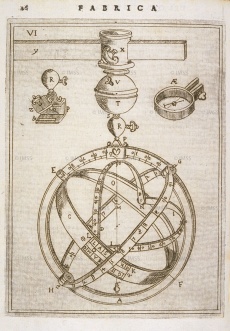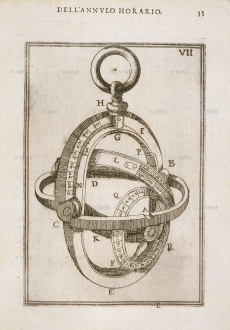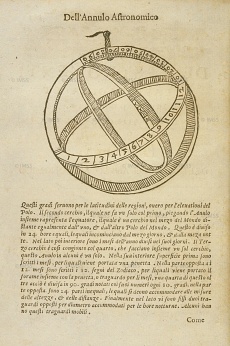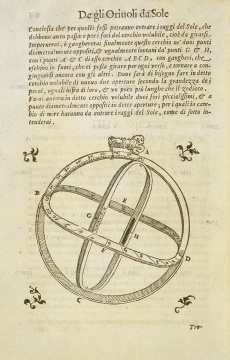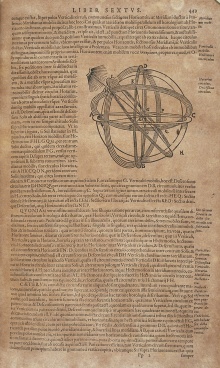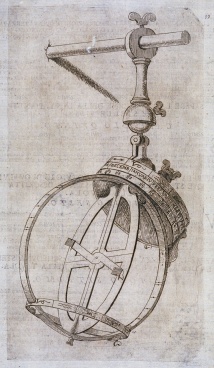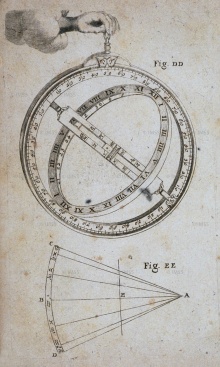Astronomical Ring
From Inventions
| (5 intermediate revisions not shown) | |||
| Line 5: | Line 5: | ||
|descrizione= | |descrizione= | ||
| - | Sundial with armillae (rings). The Sun's ray shows the time when it passes through a hole bored in one of the rings and strikes the opposite inner face of that ring, which carries the set of hour lines. The armillae indicate the main circles of the celestial sphere: meridian, equator, and solstitial colure. If it carries the shadow scale, the ring dial can also be used to measure distances. The variety of its functions is illustrated in the collection of writings by several authors (including Regiomontanus, Reiner Gemma Frisius, and Oronce Finé) printed in Paris by Gulielmum Cavellat in 1557 under the title Annuli astronomici... usus. | + | Sundial with armillae (rings). The Sun's ray shows the time when it passes through a hole bored in one of the rings and strikes the opposite inner face of that ring, which carries the set of hour lines. The armillae indicate the main circles of the celestial sphere: meridian, equator, and solstitial colure. If it carries the shadow scale, the ring dial can also be used to measure distances. The variety of its functions is illustrated in the collection of writings by several authors (including Regiomontanus, Reiner Gemma Frisius, and Oronce Finé) printed in Paris by Gulielmum Cavellat in 1557 under the title ''Annuli astronomici... usus''. |
|inventore= | |inventore= | ||
| Line 28: | Line 28: | ||
|strumentiesistenti= | |strumentiesistenti= | ||
| - | [http:// | + | - Museo Galileo, Institute and Museum of the History of Science, Florence <br> |
| - | [http:// | + | [http://catalogue.museogalileo.it/object/AstronomicalRingDial.html Florence, Museo Galileo. Institute and Museum of the History of Science, inv. 2452.] <br /> |
| - | [http:// | + | [http://catalogue.museogalileo.it/object/AstronomicalRingDial_n01.html Florence, Museo Galileo. Institute and Museum of the History of Science, inv. 2451.] <br /> |
| + | [http://catalogue.museogalileo.it/object/AstronomicalRingDial_n02.html Florence, Museo Galileo. Institute and Museum of the History of Science, inv. 2453.] <br /> | ||
| + | |||
| + | |||
| + | - Museum of the History of Science, Oxford <br> | ||
| + | [http://emu.mhs.ox.ac.uk/Display.php?irn=1486&QueryPage= Museum of the History of Science, Oxford, inv. 35171]<br> | ||
| + | [http://emu.mhs.ox.ac.uk/Display.php?irn=1490&QueryPage= Museum of the History of Science, Oxford, inv. 39762]<br> | ||
| + | [http://emu.mhs.ox.ac.uk/Display.php?irn=1487&QueryPage= Museum of the History of Science, Oxford, inv. 41086]<br> | ||
| + | [http://emu.mhs.ox.ac.uk/Display.php?irn=1491&QueryPage= Museum of the History of Science, Oxford, inv. 44117]<br> | ||
| + | [http://emu.mhs.ox.ac.uk/Display.php?irn=1488&QueryPage= Museum of the History of Science, Oxford, inv. 46814]<br> | ||
| + | [http://emu.mhs.ox.ac.uk/Display.php?irn=1489&QueryPage= Museum of the History of Science, Oxford, inv. 47753]<br> | ||
| + | [http://emu.mhs.ox.ac.uk/Display.php?irn=1485&QueryPage= Museum of the History of Science, Oxford, inv. 50526]<br> | ||
| + | [http://emu.mhs.ox.ac.uk/Display.php?irn=1484&QueryPage= Museum of the History of Science, Oxford, inv. 48126]<br> | ||
| + | [http://emu.mhs.ox.ac.uk/Display.php?irn=1147&QueryPage= Museum of the History of Science, Oxford, inv. 87302]<br> | ||
| + | |||
| + | |||
|link= | |link= | ||
| + | http://www.smithsonianmag.com/science-nature/Galileos-Instruments-of-Discovery.html?c=y&page=3&navigation=thumb (English) <br> | ||
| + | http://www.louisg.net/mesure_temps2.htm (French)<br> | ||
| + | http://assprouen.free.fr/images/originaux/fiches/copies/fiche_3.pdf (French)<br> | ||
|immagini= <gallery widths=230 heights=368 perrow=3> | |immagini= <gallery widths=230 heights=368 perrow=3> | ||
Current revision as of 10:48, 7 September 2010
From the Latin annulus (ring), the term has been used since the fifteenth century.
Contents |
Historic Period
16th C.
Description
Sundial with armillae (rings). The Sun's ray shows the time when it passes through a hole bored in one of the rings and strikes the opposite inner face of that ring, which carries the set of hour lines. The armillae indicate the main circles of the celestial sphere: meridian, equator, and solstitial colure. If it carries the shadow scale, the ring dial can also be used to measure distances. The variety of its functions is illustrated in the collection of writings by several authors (including Regiomontanus, Reiner Gemma Frisius, and Oronce Finé) printed in Paris by Gulielmum Cavellat in 1557 under the title Annuli astronomici... usus.
Bibliographical Resources
Annuli astronomici... usus, Parigi, Gulielmum Cavellat,1557.
Apianus, Petrus. Cosmographia Petri Apiani per Gemmam Frisium apud Louanienses medicum & mathematicum insigne[m], iam demum ab omnibus vindicata mendis ac nonnullis quoque locis aucta figurísque nouis illustrata ; additis eiusdem argumenti libellis ipsius Ge[m]mae Frisii. Parisiis. Apud Viuantium Gaultherot ..., 1551.
Capilupi, Giulio. Fabrica et vso di alcuni stromenti horarii vniuersali ritrouati da Giulio Capilupi ... ; con altre inuentioni in simile materia .... Roma, heredi di Giouan Giliotti, 1590.
Finé, Oronce. Opere di Orontio Fineo del Delfinato diuise in cinque parti: arimetica, geometria, cosmografia, e oriuoli tradotte da Cosimo Bartoli ..., et gli specchi tradotti dal caualier Ercole Bottrigaro ... nuouamente poste in luce. Venetia, presso Francesco Franceschi senese, 1587.
Gallucci, Giovanni Paolo. Della fabrica et uso di diuersi stromenti di astronomia et cosmografia : oue si uede la somma della teorica et pratica di queste due nobilissime scienze. Venetia, appresso Ruberto Meietti, 1598.
Marinari, Onorio. Fabbrica et uso dell'annulo astronomico, instrumento universale per delineare oriuoli solari, non solo diretti, ma anco reflessi a tutte l'usanze d'ore .... Firenze, 1674.
Existing Instruments
- Museo Galileo, Institute and Museum of the History of Science, Florence
Florence, Museo Galileo. Institute and Museum of the History of Science, inv. 2452.
Florence, Museo Galileo. Institute and Museum of the History of Science, inv. 2451.
Florence, Museo Galileo. Institute and Museum of the History of Science, inv. 2453.
- Museum of the History of Science, Oxford
Museum of the History of Science, Oxford, inv. 35171
Museum of the History of Science, Oxford, inv. 39762
Museum of the History of Science, Oxford, inv. 41086
Museum of the History of Science, Oxford, inv. 44117
Museum of the History of Science, Oxford, inv. 46814
Museum of the History of Science, Oxford, inv. 47753
Museum of the History of Science, Oxford, inv. 50526
Museum of the History of Science, Oxford, inv. 48126
Museum of the History of Science, Oxford, inv. 87302
Links (External)
http://www.smithsonianmag.com/science-nature/Galileos-Instruments-of-Discovery.html?c=y&page=3&navigation=thumb (English)
http://www.louisg.net/mesure_temps2.htm (French)
http://assprouen.free.fr/images/originaux/fiches/copies/fiche_3.pdf (French)
Images
Petrus Apianus, Cosmographia Petri Apiani per Gemmam Frisium apud Louanienses medicum & mathematicum insigne[m], iam demum ab omnibus vindicata mendis ac nonnullis quoque locis aucta figurísque nouis illustrata ; additis eiusdem argumenti libellis ipsius Ge[m]mae Frisii. Parisiis, apud Viuantium Gaultherot ..., 1551, p.66v |
||
Johann Peterson Stengel, Gnomonica universalis, oder, Aussführliche Beschreibung der Sonnen Uhren: darinnen allerhand Gattungen derselben in 233 Figuren vorgestellet und wie sie auf allerley flachen Ebnen, so wol under der Sphaera recta als obliqua geometrisch aufgerissen werden : sampt einem Anhang wie man die Reflex-Uhren aufreissen soll, wie auch von allerhand beweglichen so wol universal- als particular- Sonnen Uhren, Ulm, druckts und verlegts Matthäus Wagner, 1679, fig. DD,EE |
Author of the entry: Filippo Camerota

